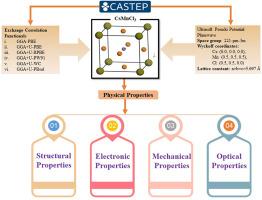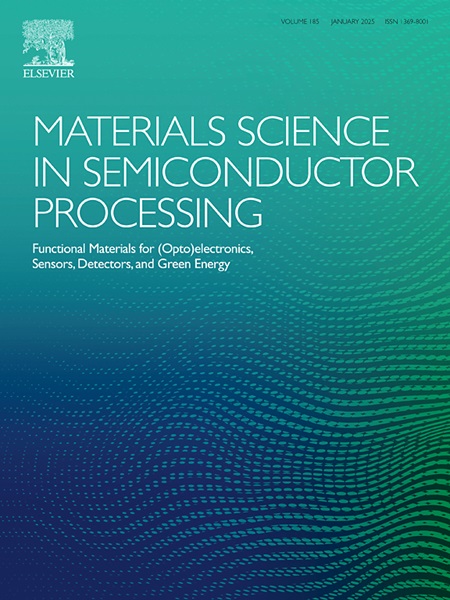揭示交换相关函数在研究光电应用中 CsMnCl3 包晶物理特性中的作用
IF 4.2
3区 工程技术
Q2 ENGINEERING, ELECTRICAL & ELECTRONIC
引用次数: 0
摘要
金属卤化物包晶因其在光伏、光电子和光催化领域的变革性应用而备受关注。本研究利用 CASTEP 代码中的 GGA-PBE 和 GGA + U 计算以及不同的交换相关函数(PBE、RPBE、PW91、WC 和 PBEsol),率先对 CsMnCl3 包晶的结构、电子、弹性、机械和光学特性进行了深入研究。CsMnCl3 包晶体的结构参数受到交换相关函数的很大影响,尤其是晶格常数,它呈现出随函数而变的特性。该材料在 GGA-PBE 下表现出金属特性,而在其他函数 GGA + U with PBE、RPBE、PW91、WC 和 PBEsol 下则表现出间接能带隙能 (R→G) 的半导体行为。值得注意的是,计算出的能带隙呈现出特定函数的变化:1.956 eV(GGA + U-PBE)、2.041 eV(GGA + U-RPBE)、1.994 eV(GGA + U-PW91)、1.890 eV(GGA + U-WC)和 1.895 eV(GGA + U-PBEsol)。该化合物在可见光区域显示出较低的反射率、较大的吸收系数值和良好的光导率。此外,博恩稳定性准则表明该材料具有机械稳定性,并且根据泊松比/普氏比具有延展性。根据各向异性指数,它具有各向异性。这些优异的结果证明它适合柔性光电应用。本文章由计算机程序翻译,如有差异,请以英文原文为准。

Unveiling role of exchange-correlation functions in investigating physical properties of CsMnCl3 perovskite for optoelectronic applications
Metal halide perovskites have garnered significant attention for their transformative applications in photovoltaics, optoelectronics, and photocatalysis. This study pioneers an in-depth examination of the structural, electronic, elastic, mechanical, and optical properties of CsMnCl3 perovskite using GGA-PBE and GGA + U calculations with diverse exchange-correlation functionals (PBE, RPBE, PW91, WC, and PBEsol) within the CASTEP code. The structural parameters of CsMnCl3 perovskite are substantially affected by the exchange-correlation function, particularly the lattice constants, which exhibit functional-dependent variations. The material demonstrates metallic properties under GGA-PBE, while it manifests semiconductor behavior with an indirect energy bandgap energy (R→G) under other functionals GGA + U with PBE, RPBE, PW91, WC, and PBEsol. Notably, the calculated energy bandgaps exhibit functional-specific variations: 1.956 eV (GGA + U-PBE), 2.041 eV (GGA + U-RPBE), 1.994 eV (GGA + U-PW91), 1.890 eV (GGA + U-WC), and 1.895 eV (GGA + U-PBEsol). The compound shows low reflectivity, a large absorption coefficient value, and good optical conductivity in the visible region. Moreover, the Born stability criterion suggests that material is mechanically stable, and ductile according to Poisson scale/Pugh's ratio. It has an anisotropic nature according to the anisotropy index. These exceptional results advocate its suitability for flexible optoelectronic applications.
求助全文
通过发布文献求助,成功后即可免费获取论文全文。
去求助
来源期刊

Materials Science in Semiconductor Processing
工程技术-材料科学:综合
CiteScore
8.00
自引率
4.90%
发文量
780
审稿时长
42 days
期刊介绍:
Materials Science in Semiconductor Processing provides a unique forum for the discussion of novel processing, applications and theoretical studies of functional materials and devices for (opto)electronics, sensors, detectors, biotechnology and green energy.
Each issue will aim to provide a snapshot of current insights, new achievements, breakthroughs and future trends in such diverse fields as microelectronics, energy conversion and storage, communications, biotechnology, (photo)catalysis, nano- and thin-film technology, hybrid and composite materials, chemical processing, vapor-phase deposition, device fabrication, and modelling, which are the backbone of advanced semiconductor processing and applications.
Coverage will include: advanced lithography for submicron devices; etching and related topics; ion implantation; damage evolution and related issues; plasma and thermal CVD; rapid thermal processing; advanced metallization and interconnect schemes; thin dielectric layers, oxidation; sol-gel processing; chemical bath and (electro)chemical deposition; compound semiconductor processing; new non-oxide materials and their applications; (macro)molecular and hybrid materials; molecular dynamics, ab-initio methods, Monte Carlo, etc.; new materials and processes for discrete and integrated circuits; magnetic materials and spintronics; heterostructures and quantum devices; engineering of the electrical and optical properties of semiconductors; crystal growth mechanisms; reliability, defect density, intrinsic impurities and defects.
 求助内容:
求助内容: 应助结果提醒方式:
应助结果提醒方式:


